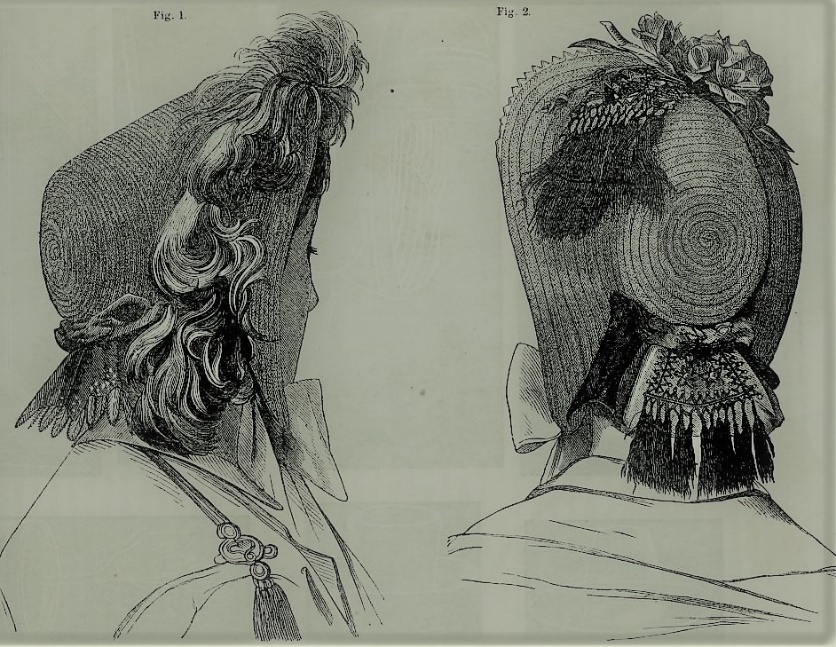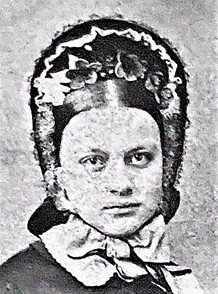In 1860, women of almost all social classes purchased clothing from milliners and dressmakers: goods were made to order usually in a small shop with a female entrepreneur. Dressmaking and millinery was one of the few paths to independence for the working class daughter…a risky business and few women became wealthy but many did manage to maintain a “precarious independence.”1
Hats and bonnets were an essential part of a woman’s attire as well as a fashion statement. A visit to the milliners was always a treat, but especially when the newest fashions for Spring and Fall were unveiled. While caps, hats, and plain bonnets were always available in a milliner’s shop, women could select a hat or a bonnet already trimmed, or choose ribbons, artificial flowers or feathers and have the milliner trim it for them.
The 1860 U. S. Census for Newville recorded the occupations of seven women as milliners, and they were all single except for widow Elizabeth Reed. Barbara Ginter, aged 19, M.E. Gibler, aged 17, 29-year old Harriet McLaughlin who lived at home, Ellen Dean and Martha Wimer who lived together, and Elizabeth Reed, aged 35, and Mary Elliott, aged 30, who also lived together. It is likely that 19-year-old Barbara Ginter and 17-year-old M. E. Gibler worked for the other milliners.
A study of the advertisements in the Newville newspapers of the 1860s shows that with one exception, all the milliners were unmarried women. Most were in business for only a few years, operating out of rented rooms and relocating frequently.

The Star and Enterprise, Newville, May 10, 1860
The Misses Ellen Deen, aged 34 in 1860, and Martha Wimer, aged 25, combined millinery and mantua making. They worked out of a room they rented north of Mr. Stough’s store. By 1870, they were no longer milliners. Both were still single and living in different households working as housekeepers.
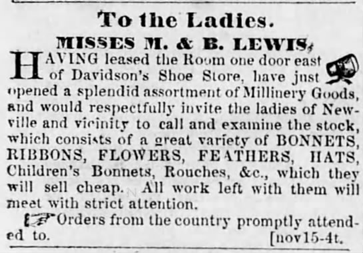
The Star and Enterprise, Newville, November 15, 1860
In November 1860, the Misses M. and B. Lewis opened their millinery shop in a room they leased one door east of Davidson’s Shoe Store. They advertised that they had a “splendid assortment” of bonnets and hats, as well as ribbons, flowers, and feathers, etc. Nothing more is known of them or their business.
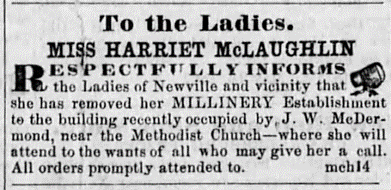
The Star and Enterprise, Newville, May 30, 1861
Harriet McLaughlin (later Mrs. Harriet Stough) operated her millinery business from the late 1850s until 1902. In 1860, she was living at home with her widowed mother, her brother Charles Tidings, a tailor, and her sister Mary. She may have worked from home at first, but in 1861 she removed her shop to a building near the Methodist Church on West Main Street. When Messrs. Thomas & Co. grocery closed in 1872, Harriet bought their millinery stock and moved into their former store.2
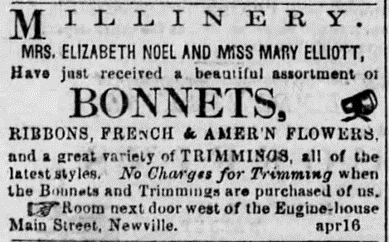
The Star and Enterprise, Newville, April 16, 1863
In 1860, milliners Mrs. Elizabeth Reed, a 35-year-old widow, Miss Mary Elliott, aged 30, and Mrs. Reed’s eight-year-old daughter were living together. It is likely that Mrs. Reed was Mary Elliott’s sister. Mrs. Reed married Jacob Noel in November 1860. In 1863, she and Mary Elliott advertised that their shop was located in the room next door west of the Engine House on Main Street. They had just received an assortment of bonnets, ribbons, French and American flowers, and trimmings all in the latest styles. They offered customers who purchased bonnets from their shop to trim them free of charge.
By 1864, Mary Elliott was in business for herself, and every few years she changed locations. She ordered goods from Philadelphia as well as making trips to New York to purchase the latest seasonal bonnets, hats, and trimmings for her shop.
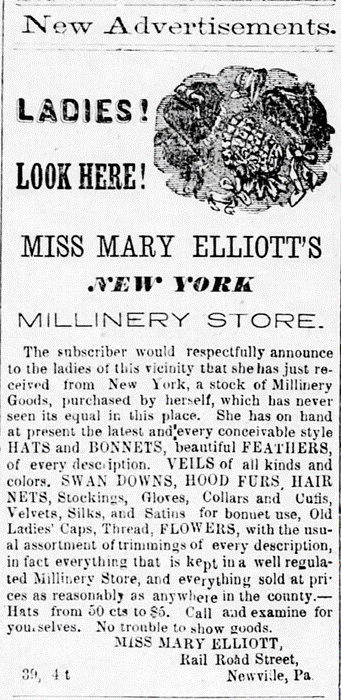
The Star and Enterprise, Newville, October 30, 1869
Mary Elliott’s 1869 advertisement proclaimed that she had personally purchased the finest stock of millinery goods in New York that had ever been seen in Newville. Her stock included “every conceivable style of hats and bonnets. Feathers of every description, colored veils, hood furs, hair nets, swan downs, stockings, gloves, collars and cuffs, velvets, silks and satins for bonnets, thread flowers,” and other trimmings. Hats could be had from fifty cents to $5.
There are no advertisements for Mary Elliott after 1869, and she does not appear on the 1870 Census in Newville or Cumberland County.
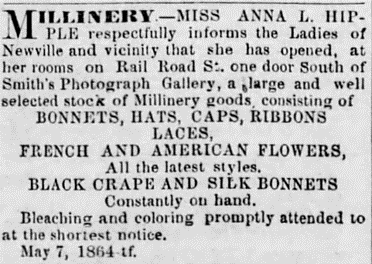
The Star and Enterprise, Newville, May 21, 1864
Miss Anna L. Hipple was in business for four years. In May 1864, she opened her millinery shop in rooms on Rail Road Street, one door south of Mrs. Smith’s Photograph Gallery. By 1866 she had moved her store to the front room above Walkers & Grahams grocery on Rail Road Street, and as well as selling millinery goods, she was also making mantuas.3 She went out of business in 1868, and on May 2 an auction of her entire stock of millinery goods was held at her house on Main Street.
Miss M. E. Smiley may have purchased Miss Hipple’s stock because her first advertisement appeared in October 1868. She announced that the grand opening of fall and winter millinery would be held on Saturday, October 31 at her shop on Rail Road Street opposite James & Bros. store.4 On July 2, 1870, a public sale of her household furniture was held, and it is likely that she closed her business then.
